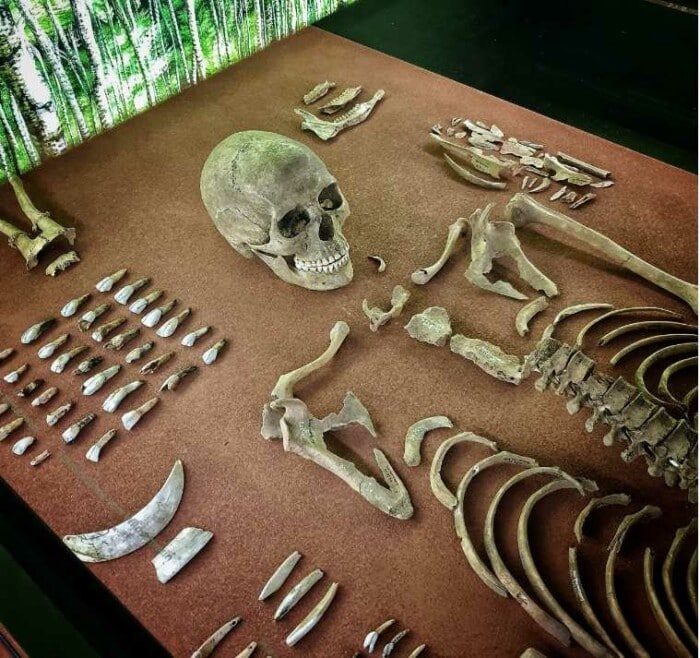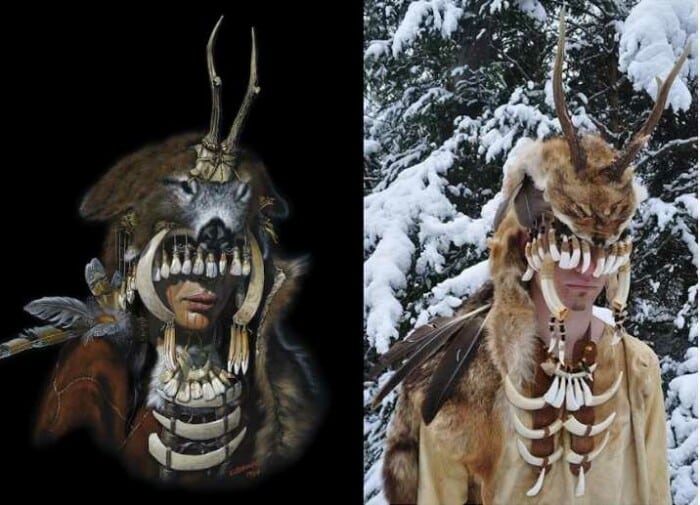
A Mysterious Skeleton in a Glass Case
In a dark corner of a museum in Germany, a skeleton lies in a glass case. It looks like any other ancient skeleton, except for one thing: it wears a headdress made from animal bones and teeth. It is one of the oldest burials in central Germany, dating back to about 9,000 years ago. But who was this person and why was she buried with such strange objects? The answer will surprise you.
A Nazi Mistake
The skeleton was found in 1934 during the construction of a bridge over a river near the town of Bad Dürrenberg in eastern Germany. The workers who found it alerted the local authorities, who sent a team of archaeologists led by Alfred Götze. Götze was a Nazi sympathizer who believed in the racial superiority of the so-called “Aryan” people. He was eager to find evidence of their ancient origins and culture.
Götze and his team excavated the skeleton and assumed it was that of a rich man, a leader or a warrior of his tribe. He thought that the animal bones were trophies or offerings from his followers, and that the infant buried next to him was his son or heir. He also thought that the skeleton had white skin, blue eyes and blond hair, like the ideal Nazi. He did not consider the possibility that the skeleton was that of a woman or a shaman.
He wrote in his report: “The grave belongs to an original Aryan man who lived at the end of the Ice Age. He was a leader of his tribe and had many followers who honored him with gifts. He had a son who died with him and was buried beside him. He had white skin, blue eyes and blond hair, like all true Aryans.”
But Götze was wrong about almost everything.

A Powerful Woman
The skeleton remained in obscurity for decades, until new scientific methods and perspectives challenged Götze’s interpretation. In 2008, Harald Meller, the director of the State Museum of Prehistory, decided to re-examine the skeleton and its grave goods using modern techniques such as genetic analysis, magnetic resonance imaging and dental examinations. He also consulted with experts from various fields such as anthropology, ethnology and history.
Meller and his team discovered that Götze had been wrong about almost everything. The skeleton was not that of a man, but a woman, aged between 25 to 35 years. She had a malformation in her upper cervical vertebrae that may have caused involuntary eye movement and made her a special person. She also had dark skin, brown eyes and dark hair, unlike the white-skinned, blue-eyed, blond-haired ideal of the Nazis.
Meller said: “Rarely have people been so mistaken about a person as they were about this woman. She was not an Aryan man, but a dark-skinned woman who lived in the Stone Age. She was not a leader or a warrior, but a shaman who mediated between her community and the spirit world.”
The grave goods also had a different meaning than what Götze had assumed. The animal bones were not trophies or offerings, but part of a headdress that may have been used for shamanic rituals. The woman was most likely a shaman, a border crosser to the spirit realm who mediated between her community and the forces of nature. She lived in a time when people had to adapt to changing environmental conditions after the end of the last Ice Age. She may have helped her people cope with these changes by providing guidance, healing and protection through her rituals.
Meller explained: “The headdress was made from bones and teeth of different animals such as deer, wild boar, crane and turtle. These animals may have represented different spirits or qualities that she could invoke or communicate with. The turtle shells may have served as rattles that helped her induce trance states. The infant buried with her may have been her apprentice or companion who shared her visions.”

A Remarkable Discovery
The grave of the shaman of Bad Dürrenberg is one of the most remarkable archaeological discoveries in Germany. It sheds light on the life and beliefs of the people of the Middle Stone Age, who were hunter-gatherers and fishers living in forests and along rivers. It also challenges the stereotypes and prejudices of the Nazi ideology, which distorted and manipulated the past to serve its political agenda. It shows that the history of humanity is more diverse and complex than what some may want us to believe.
Meller said: “The grave of the shaman of Bad Dürrenberg is a unique testimony of the cultural heritage of our ancestors. It reveals a fascinating and mysterious woman who lived in harmony with nature and had a special connection to the spirit world. It also exposes the lies and propaganda of the Nazis, who tried to erase the diversity and complexity of our past.”
The shaman of Bad Dürrenberg is a fascinating and mysterious woman who still has many secrets to reveal. She invites us to explore our ancient roots and to appreciate the richness and diversity of our cultural heritage. She also reminds us of the power and wisdom of women who have played important roles in the history of humankind.










